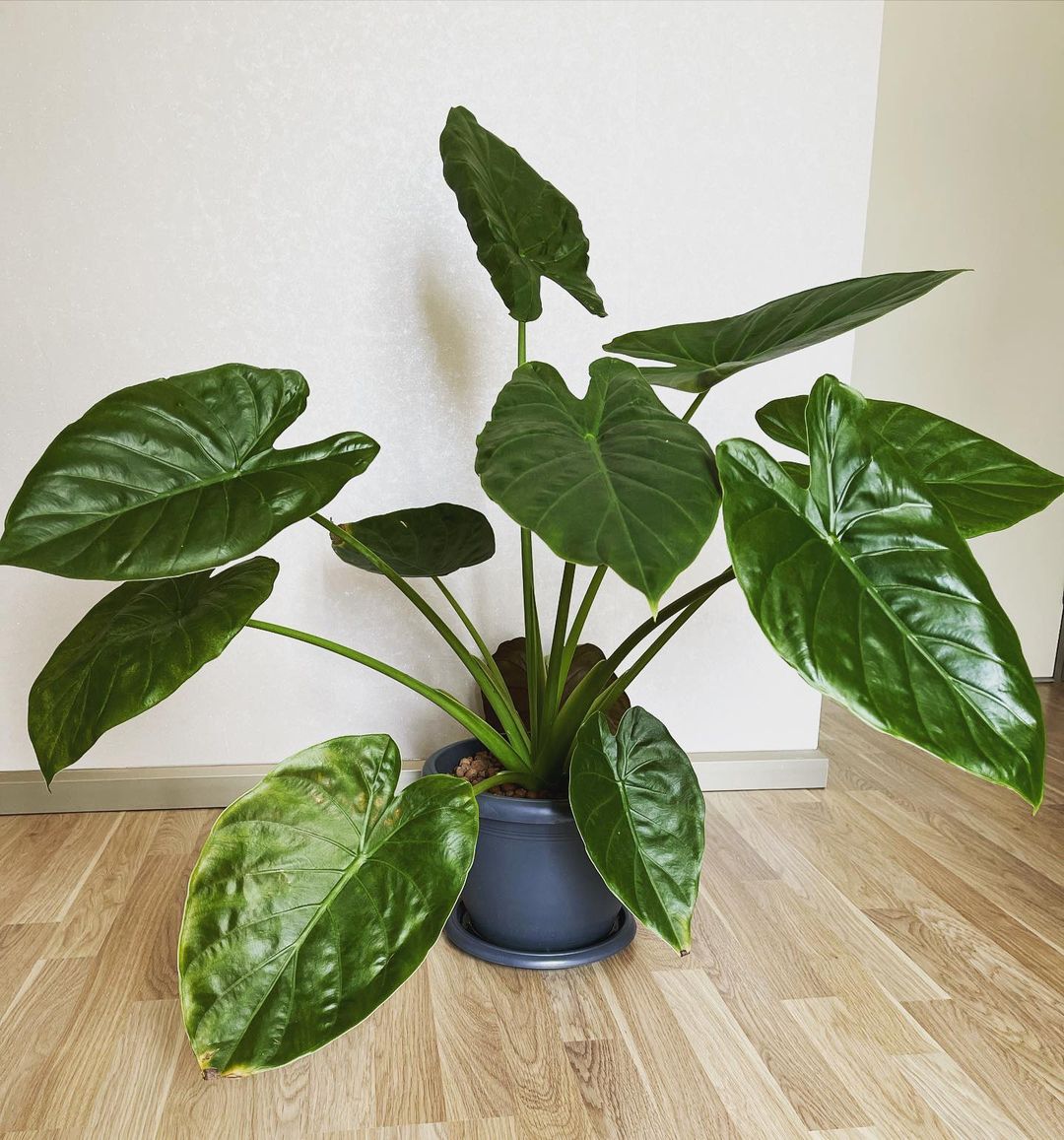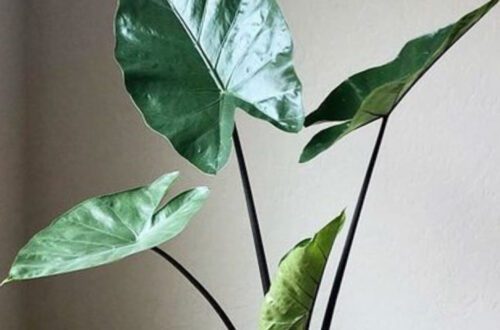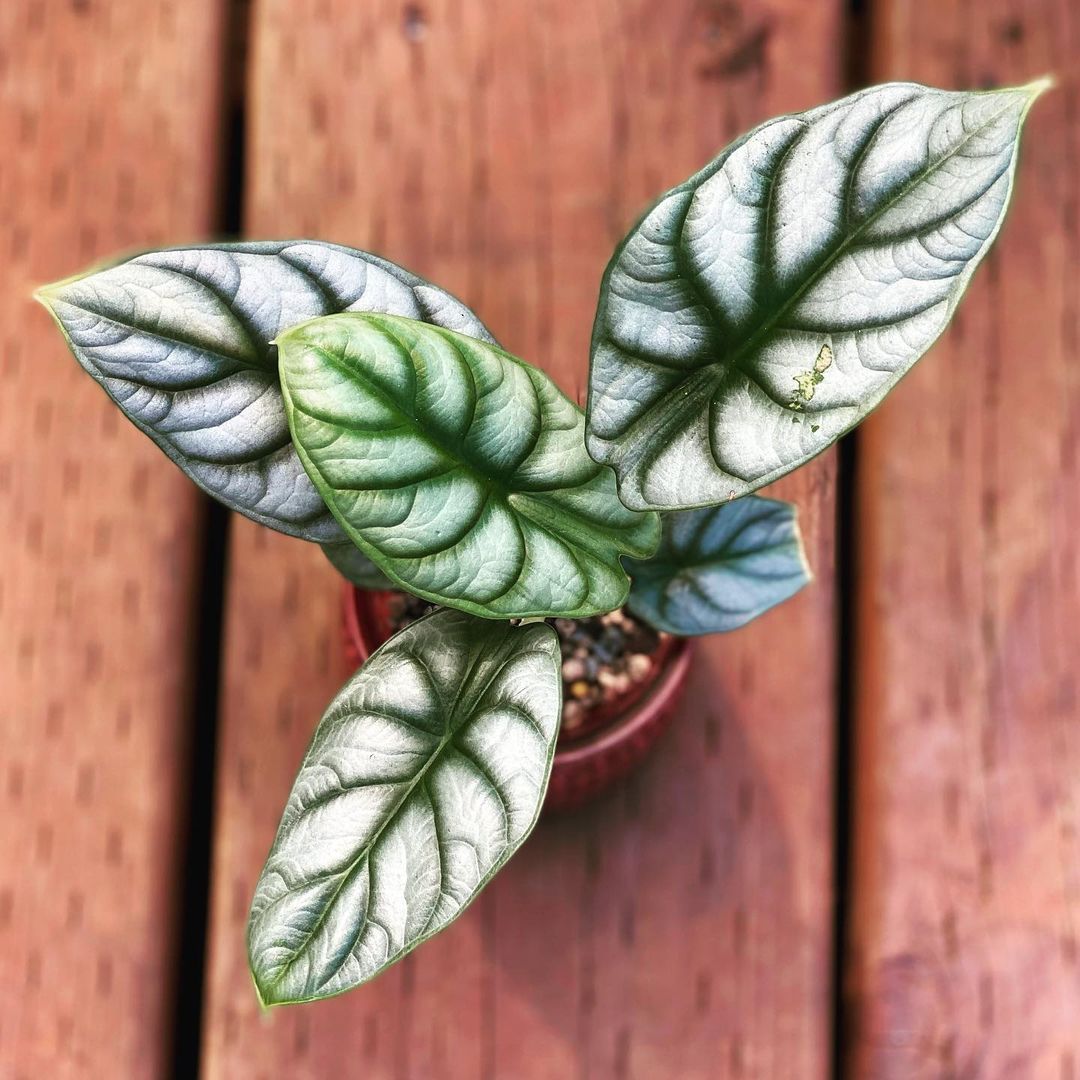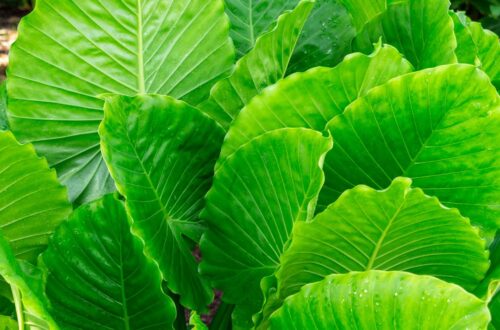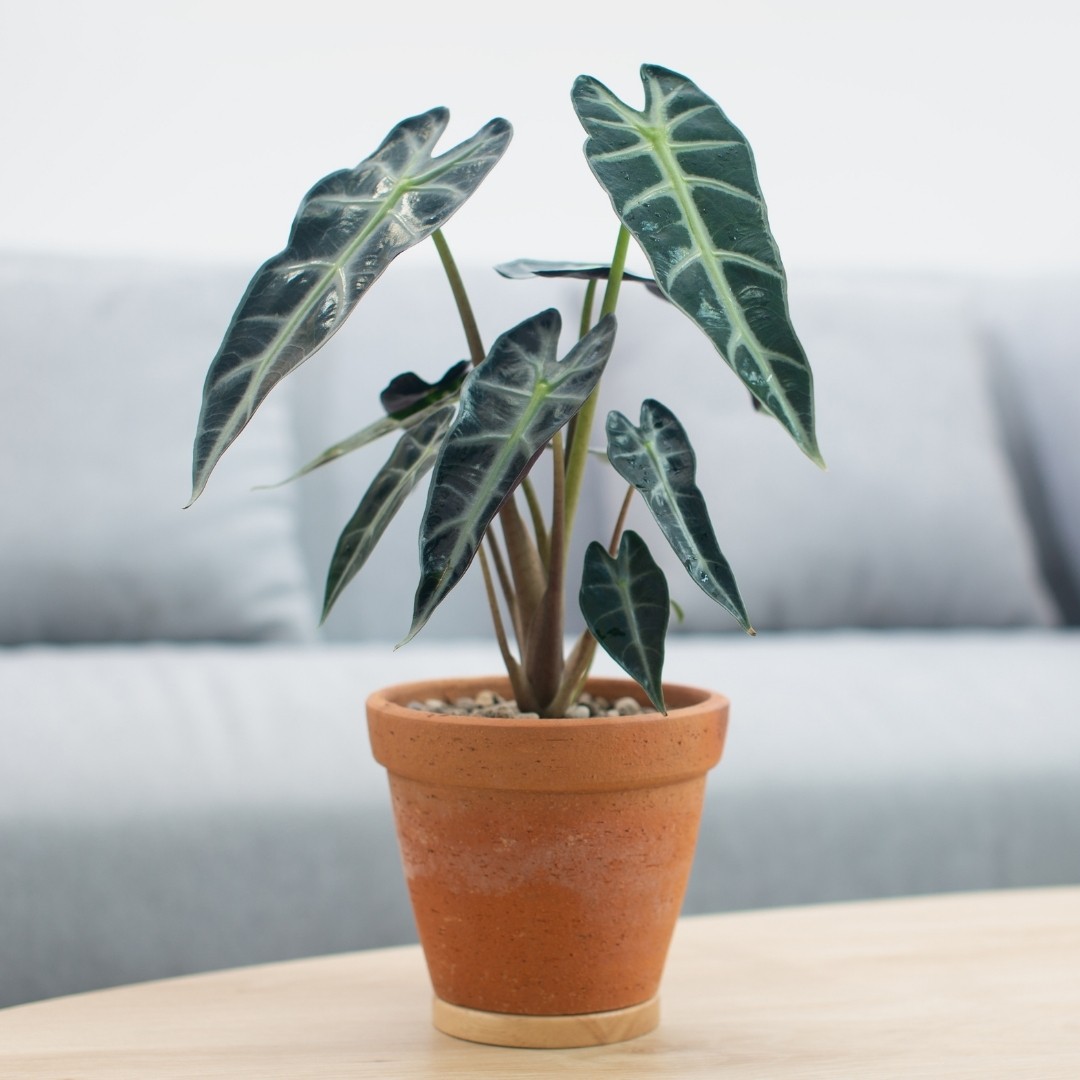
Alocasia Care
Alocasia care comes down to keeping them moist and humid, but being careful of pests and waterlogging, they are a little bit fussy but as long as you get these few things right you should be well on your way to have a happy alocasia…
Alocasia Care Summary
| Light needs: | Bright but indirect sunlight |
| Watering needs: | Check the soil weekly, water it if the top 50% is dry. Keep it moist but not wet. |
| Fertilizer: | Feed them once a month in summer with a general purpose fertilizer. |
| Soil: | A well-draining peat-based potting compost. |
| Humidity: | 60%-70% humidity. |
| Temperature: | 18-30°C (64-86°F). The warmer end of household temperatures. |
| Where to buy: | Try our list of Rare Plant Shops or Etsy. |
| Other names: | Elephant ear alocasia, alocasia zebrina, alocasia polly, alocasia frydek. |
| Common issues: | Alocasia can be susceptible to spider mites or scale insects. |
Intro
Welcome to our guide to alocasia care. Alocasias are a genus of plants which include some of my favorites like the alocasia polly and frydek. Their jagged and pointed unique-shaped leaves are the main features of this beautiful genus of tuberous tropical houseplants.
Tip: we recommend Etsy for buying plants. Look for the best rated seller you can, and try to buy as close to your home as possible so the plant does not travel too far.
A note about affiliate links: when you buy a plant, pots, soil, or other goods through links on this article we sometimes earn a commission. It doesn’t cost you anything, but it really helps us out if you do use them. Thanks a lot! An example of this is if you buy a plant on Etsy using this link. Read our privacy policy for more information. Thanks again.
Light Needs
Alocasias need bright but indirect sunlight. Those leaves need a lot of light energy to maintain them, but their beautiful foliage will burn if given too much direct sun.
See also: Alocasia Soil, Alocasia Azlanii, Alocasia Regal Shields, Alocasia Low Rider, Alocasia Lauterbachiana,
How Often to Water An Alocasia
Check the soil weekly, water it if the top 50% is dry. Keep it moist but not wet.
Test it with your finger to make sure at least half of your finger is dry when sticking it down into the soil. Go to water it each week and only do so if the top layer is dry. In the winter when the plants grow less they will need much less water, but apply the same technique to test to see if they need any.
Fertilizer
Do not feed your alocasia in the winter, but in the summer you can feed them once a month with a general purpose fertilizer. As with all fertilizer feeding, always use a diluted dose on the first time and check for leaf burning/browning.
Soil
Use a well-draining peat-based potting compost. You can consider adding some perlite, as alocasias like their environment to be well-draining. They like to be wet but not sitting in water or water logged as this can cause root rot.
For more on which soil to buy or how to make your own see our guide: Alocasia Soil.

When To Repot An Alocasia
If the plant is root bound, then repot your alocasia up a pot size. Do this in spring before the warmer growing months, and plant it up one or two pot sizes.
Humidity
Alocasias like humidity, or their leaves ill go crispy. They like to misted at watering a the very least, and will like 60%-70% humidity levels if possible, which is like the high end of a household bathroom humidity. So mist them regularly and set up a pebble tray if you can.
Tip: Keep them humid, aim for 60% in the day and they’ll be ok with a bit less at night. You can buy a humidity meter (affiliate link) to keep an eye on maximum and minimum levels.
Temperature
Alocasias like the warmer end of household temperatures. Keep them in a warm window, but do not let them get exposed to cold drafts in the winter. Their ideal temperature rand is 18-21°C (64-70°F), so they’ll do well in most households.
How To Propagate Alocasia
Alocasias grow from tubers, so you need to wait for a smaller alocasia pup to grow at the base of the main plant. You cannot take a stem cutting like you can with a monstera for example. The plant will grow up and the tuber will grow wider under the soil and put up more smaller plants are the base. At this point you can then separate it out by taking the plants out of their container, taking as much soil off as you can and breaking the smaller pup plant off, being careful to take a small part of the tuber and roots with it, try to damage it as little as possible. Then pot them up separately.
Alocasia USDA Zone
Zones 9-11.
Where Are Alocasia Native?
They grow in southern Asia and parts of Australia.
Why Is My Alocasia Dripping Water?
They can grip water from the leaves when they have just been watered. It is called ‘guttation’ and quite common in alocasias, especially when they have plenty of water.
When Do Alocasia Produce Bulbs/Corms?
As an alocasia matures it will produce little corms which eventually turn into small plants. You can often find some when you repot your alocasias. They can be easily taken out and planted up separately to propagate a new plant.
How To Grow A Alocasia Corm
You can remove the corms when repotting, they will be close to the tuber / roots underneath the plant. They may be attached to the roots, you can remove them carefully with scissors.
Then you can pot them up in their own pots. I would use moss as they seem to thrive in moss as you can get much less rot than with soil, and a lot of moisture and air to the roots. Wash as much of the soil off as you can.
You want to plant it so that the top part that will sprout is just poking out of the moss and the rest is buried. The top part can normally be identified as it is pointy and should be pointing upwards (sometimes it has a shoot coming out of it so it is obvious at that stage!).
Tip: you can scrape off the darker outer shell/layer with you finger nail or the back of a knife (be careful!) and it will root quicker.
You want to keep it really humid until it spouts, put the whole thing inside a bigger plastic box with the lid on but not closed and allowing a little bit of air to circulate. This way you can get high humidity but less rot as air can move.
Keep it warm and in indirect sunlight and it should root and then sprout over the next few weeks and months.
For more on alocasias see our alocasias category with all our different care and propagation guides.
Can Alocasia Take Full Sun?
If you live in a very hot lace then full sun can be too much for them, but they can take full sun in some parts of the world. They can certainly take early morning and late afternoon sun, an will grow better if given it. If you have a new plant that has been grown indoors and you want it to grow outdoors it is a good idea to transition it slowly by moving it to place where it only get a bit of sunlight, then every few days move it so it gets a bit more sun. Keep an eye on it and move it back under more shade if it shows any signs of burn. Theis way you can gradually get it used to taking full sun.

Can Alocasia Grow In Water?
They can be grown in water alone. Transitioning them there is the hard part. You need to remove all of the soil from the plant and put it in water, but sometimes they can die from shock. They best method in y opinion is to get a corm and root it in leca, and then when it has stated to root, and has decent sized roots and some growth out the top, remove the leca and continue to grow it in water alone.
Can Alocasia Grow In Leca?
They can grow well in leca, make sure you wash the leca first, as you should always do. If you are propagating with leca, you can root a corm in leca and they tend to take well. If you are separating out a plant that was grown in soil, it can be more tricky you want to get all the soil off by washing the roots thoroughly. You must make sure that the roots are not in the water, so use a tall pot and ensure the water level is under the roots. Rot can be a big issue when transitioning plants to leca from soil. You want to water it with just water to start and then after a few weeks use a really weak fertilizer solution and then gradually increase the dose very slowly so you do not shock the plant.
Where To Buy An Alocasia
I find the best places to get Alocasias are from specialist plant traders. See our article Rare Plant Shops for more info. Or Etsy.
Other Names for Alocasia
There are many names for the different types of alocasia, like the elephant ear alocasia, alocasia zebrina, alocasia polly or alocasia frydek.

Alocasia Care FAQs and Common Problems
Alocasias can be susceptible to pests. The good news is that they get less pests if they are kept humid. If they get spider mites or scale insects they can be treated with a cotton bud and rubbing alcohol to get rid of the bad ones, and if it is only a small issue you can spray the leaves with water and washing up liquid and wipe them down.
For more info on pests see our articles on Houseplant Pests and Problems.
Alocasia Frydek Vs Polly
The frydek has a much lusher green color to its leaves, the polly’s have a very glossy texture and more jagged edges to them.
Do Alocasia Like To Be Root Bound?
They are ok to be root bound, but not very crowded.
Do Alocasia Go Dormant?
When it gets cold it is normal for alocasias to stop growing for a period. It is very important to check the soil before watering in the winter as they may hardly need any water at all and so can be easily overwatered.
Can Alocasia Grow In Water?
You can transition an alocasia from water to soil. It is best to do it with a young pup. You must clean all the soil form the roots and tuber before putting it in water to grow water roots and adapt.
Why Are My Alocasia Leaves Curling?
The most common reason is lack of moisture in the leaves, so make sure your plant is well watered and humid. It could also be too much direct sun.
Is Alocasia Toxic To Cats?
They are toxic to cats and dogs if eaten, they can cause vomiting. Seek vets advice.
Why Is My Alocasia Turning Yellow?
Often leaves turn yellow and can fall off due to not enough water or humidity, which is easy to remedy, But be careful as it can also be a sign of overwatering. Check the soil is dry first before watering. If the soil is wet and the plant is overwatered, then take it out of its soil, let it dry out and then repot it in dry compost.
Brown Patches on Leaves
Alocasia tend to get brown patches from sunburn – be careful of direct sunlight and move the plants back from the light.
Crispy Crunchy Leaves
If the leaves start to go crunchy on your alocasia it is due to a lack of water in the leaves, which is from underwatering or not enough humidity (or both).
Why Is My Alocasia Drooping?
Drooping is a symptom of many issues, the most common one being overwatering. Check the soil and if it is wet, then dry the roots out and repot, then water regularly, but check the top layer of soil is dry before watering again.
How To Trim An Alocasia Polly?
You can use clean, sharp scissors to trim off leaves. Cut the branch as close to the base as possible with a clean cut. Make sure you do not damage the other branches.
Additional Resources
Buy: we recommend a digital thermometer hygrometer (amazon affiliate link) to measure humidity.
Links:
- More info on the Wikipedia page.
Other Articles You Might Like
Hope you found our alocasia care article helpful. You might like our other articles on Anthurium Care, Caladium Plant Care and Neon Pothos Care.
Pleas also follow us on Instagram for regular plant pics and updates., as well as the occasional plant giveaway… https://www.instagram.com/teakandterracotta/

